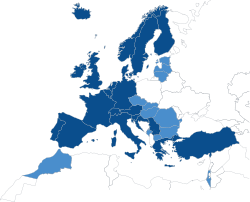European Centre for Medium-Range Weather Forecasts
Coordinates: 51°25′10″N 0°57′03″W / 51.41956°N 0.95077°W
 | |
| Formation | 1975 |
|---|---|
| Headquarters | Reading, United Kingdom |
| Website | http://www.ecmwf.int/ |
The European Centre for Medium-Range Weather Forecasts, ECMWF, is an independent intergovernmental organisation supported by most of the nations of Europe and is based at Shinfield Park, Reading, United Kingdom. It operates one of the largest supercomputer complexes in Europe and the world's largest archive of numerical weather prediction data.[1]
Background
ECMWF was established in 1975, in recognition of the need to pool the scientific and technical resources of Europe's meteorological services and institutions for the production of weather forecasts for medium-range timescales (up to approximately two weeks) and of the economic and social benefits expected from it.

It comprises 22 European countries:
- the eighteen founding states of 1975: Austria, Belgium, Croatia, Denmark, Finland, France, Germany, Greece, Republic of Ireland, Italy, Luxembourg, Netherlands, Norway, Portugal, Spain, Sweden, Switzerland, Turkey, United Kingdom.
- four states that joined since 2010: Iceland (April 2011),[2] Slovenia (December 2012),[3] Serbia (January 2015)[4] and Croatia (January 2016).[5]
It also has co-operation agreements with other states: Bulgaria, Czech Republic, Estonia, Hungary, Israel, Latvia, Lithuania, Macedonia, Montenegro, Morocco, Romania and Slovakia.
The Centre employs about 280 staff, mostly appointed from across the member states and co-operating states.[1]
Objectives
ECMWF aims to provide accurate medium-range global weather forecasts out to 15 days and seasonal forecasts out to 12 months.[6] Its products are provided to the national weather services of its member states and co-operating states as a complement to their national short-range and climatological activities, and those national states use ECMWF's products for their own national duties, in particular to give early warning of potentially damaging severe weather.
ECMWF's core mission is to:
- produce numerical weather forecasts and monitor the Earth-system;
- carry out scientific and technical research to improve forecast skill;
- maintain an archive of meteorological data.
To deliver this core mission, the Centre provides:
- twice-daily global numerical weather forecasts;
- air quality analysis;
- atmospheric composition monitoring;
- climate monitoring;
- ocean circulation analysis;
- hydrological prediction.
The Centre develops and operates global atmospheric models and data assimilation systems for the dynamics, thermodynamics and composition of the Earth's atmosphere and for interacting parts of the Earth-system. It uses numerical weather prediction methods to prepare forecasts and their initial conditions, and it contributes to monitoring the relevant parts of the Earth system.
Work and projects
Forecasting
Numerical weather prediction (NWP) requires input of meteorological data, collected by satellites and earth observation systems such as automatic and manned stations, aircraft, ships and weather balloons. Assimilation of this data is used to produce an initial state of a computer model of the atmosphere, from which an atmospheric model is used to forecast the weather. These forecasts are typically:
- medium-range forecasts, predicting the weather up to 15 days ahead
- monthly forecasts, predicting the weather on a weekly basis 30 days ahead
- seasonal forecasts up to 12 months ahead.
Over the past three decades ECMWF's wide-ranging programme of research has played a major role in developing such assimilation and modelling systems. This improves the accuracy and reliability of weather forecasting by about a day per decade, so that a seven-day forecast now (2015) is as accurate as a three-day forecast was four decades ago (1975).[7]
Monthly and seasonal forecasts
ECMWF's monthly and seasonal forecasts provide early predictions of events such as heat waves, cold spells and droughts, as well as their impacts on sectors such as agriculture, energy and health. Since ECMWF runs a wave model, there are also predictions of coastal waves and storm surges in European waters which can be used to provide warnings.
Early warning of severe weather events
Forecasts of severe weather events allow appropriate mitigating action to be taken and contingency plans to be put into place by the authorities and the public. The increased time gained by issuing accurate warnings can save lives, for instance by evacuating people from a storm surge area. Authorities and businesses can plan to maintain services around threats such as high winds, floods or snow.
In October 2012 the ECMWF model suggested seven days in advance that Hurricane Sandy was likely to make landfall on the East Coast of the United States.[8] It also predicted the intensity and track of the November 2012 nor'easter, which impacted the east coast a week after Sandy.
ECMWF's Extreme Forecast Index (EFI) was developed as a tool to identify where the EPS forecast distribution differs substantially from that of the model climate. It contains information regarding variability of weather parameters, in location and time and can highlight an abnormality of a weather situation without having to define specific space- and time-dependent thresholds.
Satellite data
ECMWF, through its partnerships with EUMETSAT, ESA, the EU and the European Science community has established a leading position for Europe in the exploitation of satellite data for operational numerical weather prediction, and for operational seasonal forecasting with coupled atmosphere-ocean-land models. The increasing amount of satellite data and the development of more sophisticated ways of extraction information from that data have made a major contribution to improving the accuracy and utility of NWP forecasts. ECMWF continuously endeavours to improve the use of satellite observations for NWP.
Reanalysis
ECMWF makes significant contributions to support research on climate variability, pioneering an approach known as reanalysis. This involves feeding weather observations collected over decades into a NWP system to recreate past atmospheric, sea- and land-surface conditions over specific time periods to obtain a clearer picture of how the climate has changed. Reanalysis provides a four-dimensional picture of the atmosphere and effectively allows monitoring of the variability and change of global climate, thereby contributing also to the understanding and attribution of climate change.
To date, and with support from Europe's National Meteorological Services and the European Commission, ECMWF has conducted two major reanalyses of the global atmosphere: the first ECMWF re-analysis (ERA-15) project generated reanalyses from December 1978 to February 1994; the ERA-40 project generated reanalyses from September 1957 to August 2002.
Operational forecast model
ECMWF's operational forecasts are produced from its "Integrated Forecast System" (sometimes informally known in the USA as the "European model") which is run every twelve hours and forecasts out to ten days.
It includes both in a "deterministic forecast" mode and as an ensemble. The deterministic forecast is a single model run that is relatively high in both resolution but also in computational expense. The ensemble is relatively low (about half that of the deterministic) in resolution and so in computational expense, so less accurate. But it is run 51 times in parallel, from slightly different initial conditions to give a spread of likelihood over the range of the forecast.[9]
See also
References
- 1 2 "Who we are". ECMWF. Retrieved 2016-01-01.
- ↑ Iceland is the first new Member State under the amended Convention. The original Convention restricted membership to the founding Member States, but was amended in June 2010.
- ↑ "Slovenia becomes ECMWF's 20th Member State". ecmwf.int. ECMWF. Retrieved 8 December 2012.
- ↑ "Serbia becomes ECMWF's 21st Member State".
- ↑ http://www.ecmwf.int/en/about/media-centre/news/2016/croatian-flag-raised-ecmwf
- ↑ Deutscher Wetterdienst. "ECMWF - European Centre for Medium-Range Weather Forecasts". Berlin, Germany: Federal Ministry of Transport and Digital Infrasctructure. Retrieved 29 April 2014.
Established in 1975, ECMWF is renowned worldwide for providing the most accurate medium-range global weather forecasts up to 10 days ahead, monthly forecasts and seasonal outlooks to six months ahead.
- ↑ "The Forecast For Weather Technology". Sky News. 2015-07-17. Retrieved 2016-01-01.
- ↑ Roulstone, Ian; Norbury, John (25 July 2013). "How Math helped forecast Hurricane Sandy". Scientific American. Retrieved 9 August 2013.
- ↑ "Modelling and Prediction". ECMWF. Retrieved 2016-01-02.
Further reading
- Woods, Austin (2006). Medium-Range Weather Prediction – the European Approach. Springer. ISBN 978-0-387-26928-3.
